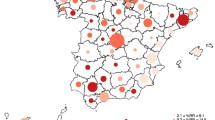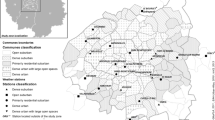Abstract
Epidemiological time series studies suggest daily temperature and humidity are associated with adverse health effects including increased mortality and hospital admissions. However, there is no consensus over which metric or lag best describes the relationships. We investigated which temperature and humidity model specification most adequately predicted mortality in three large European cities. Daily counts of all-cause mortality, minimum, maximum and mean temperature and relative humidity and apparent temperature (a composite measure of ambient and dew point temperature) were assembled for Athens, London, and Rome for 6 years between 1999 and 2005. City-specific Poisson regression models were fitted separately for warm (April–September) and cold (October–March) periods adjusting for seasonality, air pollution, and public holidays. We investigated goodness of model fit for each metric for delayed effects up to 13 days using three model fit criteria: sum of the partial autocorrelation function, AIC, and GCV. No uniformly best index for all cities and seasonal periods was observed. The effects of temperature were uniformly shown to be more prolonged during cold periods and the majority of models suggested separate temperature and humidity variables performed better than apparent temperature in predicting mortality. Our study suggests that the nature of the effects of temperature and humidity on mortality vary between cities for unknown reasons which require further investigation but may relate to city-specific population, socioeconomic, and environmental characteristics. This may have consequences on epidemiological studies and local temperature-related warning systems.

Similar content being viewed by others
Abbreviations
- CI:
-
Confidence interval
- Df:
-
Degrees of freedom
- ICD:
-
International classification of diseases
- NO2 :
-
Nitrogen dioxide
- O3 :
-
Ozone
- DLNM:
-
Distributed lag nonlinear model
- GAM:
-
Generalized additive model
- AIC:
-
Akaike information criterion
- GCV:
-
Generalized cross-validation
- PACF:
-
Partial autocorrelation function
References
Allen MP (1997) The problem of multicollinearity. Springer, New York, pp 176–180, Chapter 37, Understanding Regression Analysis
Analitis A, Katsouyanni K, Biggeri A, Baccini M, Forsberg B, Bisanti L et al (2008) Effects of cold weather on mortality: results from 15 European cities within the PHEWE Project. Am J Epidemiol 168(12):1397–1408
Anderson GB, Bell ML, Peng RD (2013) Methods to calculate the heat index as an exposure metric in environmental health research. Environ Health Perspect 121:1111–1119
Armstrong B (2006) Models for the relationship between ambient temperature and daily mortality. Epidemiology 17(6):624–631
Baccini M, Biggeri A, Accetta G, Kosatsky T, Katsouyanni K, Analitis A et al (2008) Heat effects on mortality in 15 European cities. Epidemiology 19(5):711–719
Barnett AG, Tong S, Clements ACA (2010) What measure of temperature is the best predictor of mortality? Environ Res 110(6):604–611
Basu R (2009) High ambient temperature and mortality: a review of epidemiologic studies from 2001 to 2008. Environ Health 8:40
Basu R, Dominici F, Samet JM (2005) Temperature and mortality among the elderly in the United States: a comparison of epidemiologic methods. Epidemiology 16(1):58–66
Bell ML, Dominici F, Samet JM (2005) A meta-analysis of time-series studies of ozone and mortality with comparison to the National Morbidity, Mortality, and Air Pollution Study. Epidemiology 16(4):436–445
Bolker Β (2009) Dealing with quasi- models in R. The Comprehensive R Archive Network. http://cran.r-project.org/web/packages/bbmle/vignettes/quasi.pdf. Accessed 28 Nov 2012
Braga AL, Zanobetti A, Schwartz J (2001) The time course of weather-related deaths. Epidemiology 12(6):662–667
Budd GM (2008) Wet-bulb globe temperature (WBGT)—Its history and its limitations. J Sci Med Sport 11:20–32
Cheng Y, Kan H (2011) Effect of the interaction between outdoor air pollution and extreme temperature on daily mortality in Shanghai, China. J Epidemiol 22(1):28–36
Chiusolo M, Cadum E, Stafoggia M, Galassi C, Berti G, Faustini A et al (2011) Short-term effects of nitrogen dioxide on mortality and susceptibility factors in 10 Italian cities: the EpiAir Study. Environ Health Perspect 119(9):1233–1238
Curriero FC, Heiner KS, Samet JM, Zeger SL, Strug L, Patz JA (2002) Temperature and mortality in 11 cities of the eastern United States. Am J Epidemiol 155(1):80–87
Gasparrini A (2011) Distributed lag linear and non-linear models in R: the package dlnm. J Stat Softw 43(8):1–20
Gasparrini Α, Armstrong Β (2010) Time series analysis on the health effects of temperature: advancements and limitations. Environ Res 110(6):633–638
Gasparrini A, Armstrong B, Kenward MG (2010) Distributed lag non-linear models. Stat Med 29(21):2224–2234
Goodman PG, Clancy L, Dockery DW (2004) Cause-specific mortality and the extended effects of particulate pollution and temperature exposure. Environ Health Perspect 112(2):179–185
Gryparis A, Forsberg B, Katsouyanni K, Analitis A, Touloumi G, Schwartz J et al (2004) Acute effects of ozone on mortality from the “Air Pollution and Health: a European Approach” project. Am J Respir Crit Care Med 170:1080–1087
Hajat S, Sheridan SC, Allen MJ, Pascal M, Laaidi K, Yagouti A, Bickis U, Tobias A, Bourque D, Armstrong BG et al (2010) Heat-health warning systems: a comparison of the predictive capacity of different approaches to identifying dangerously hot days. Am J Public Health 100(6):1137–1144
Harrison RM, Yin J, Tilling RM, Cai X, Seakins PW, Hopkins JR et al (2006) Measurement and modelling of air pollution and atmospheric chemistry in the U.K. West Midlands conurbation: overview of the PUMA Consortium project. Sci Total Environ 360(1–3):5–25
Kalkstein LS, Valimont KM (1986) An evaluation of summer discomfort in the United States using a relative climatological index. Bull Am Meteorol Soc 67(7):842
Karanasiou A, Querol X, Alastuey A, Perez N, Pey J, Perrino C et al (2014) Particulate matter and gaseous pollutants in the Mediterranean Basin: results from the MED-PARTICLES project. Sci Total Environ 488–489:297–315
Katsouyanni K, Schwartz J, Spix C, Touloumi G, Zmirou D, Zanobetti A et al (1996) Short term effects of air pollution on health: a European approach using epidemiologic time series data: the APHEA protocol. J Epidemiol Community Health 50(Suppl 1):S12–S18
Katsouyanni K, Touloumi G, Samoli E, Gryparis A, Le Tertre A, Monopolis Y et al (2001) Confounding and effect modification in the short- term effects of ambient particles on total mortality: results from 29 European cities within the APHEA2 Project. Epidemiology 12(5):521–531
Kim YM, Kim S, Cheong HK, Kim EH (2011) Comparison of temperature indexes for the impact assessment of heat stress on heat-related mortality. Environ Health Toxicol 26:e2011009
Lajinian S, Hudson S, Applewhite L, Feldman J, Minkoff HL (1997) An association between the heat-humidity index and preterm labor and delivery: a preliminary analysis. Am J Public Health 87(7):1205–1207
Lin YK, Chang CK, Li MH, Wu YC, Wang YC (2012) High-temperature indices associated with mortality and outpatient visits: characterizing the association with elevated temperature. Sci Total Environ 427–428:41–49
Lin YK, Wang YC, Lin PL, Li MH, Ho TJ (2013) Relationships between cold-temperature indices and all causes and cardiopulmonary morbidity and mortality in a subtropical island. Sci Total Environ 461–462:627–635
Mackenbach JP, Looman CWN, Kunst AE (1993) Air pollution, lagged effects of temperature, and mortality: the Netherlands 1979-87. J Epidemiol Community Health 47(2):121–126
Metzger KB, Ito K, Matte TD (2010) Summer heat and mortality in New York City: how hot is too hot? Environ Health Perspect 118(1):80–86
Michelozzi P, Kirchmayer U, Katsouyanni K, Biggeri A, McGregor G, Menne B et al (2007) Assessment and prevention of acute health effects of weather conditions in Europe, the PHEWE Project: background, objectives, design. Environ Health 6:12
Muggeo VMR (2003) Estimating regression models with unknown break-points. Stat Med 22(19):3055–3071
Muggeo VMR (2008) Segmented: an R package to fit regression models with broken-line relationships. R News 8(1):20–25, http://cran.r-project.org/doc/Rnews/. Accessed 14 August 2013
O’Neill MS, Hajat S, Zanobetti A, Ramirez-Aguillar M, Schartz J (2005) Impact of control for air pollution and respiratory epidemics on the estimated associations of temperature and daily mortality. Int J Biometeorol 50(2):121–129
Peng RD, Dominici F, Lois TA (2006) Model choice in time series studies of air pollution and mortality. J R Stat Soc A Stat Soc 169(2):179–203
Perrakis K, Gryparis A, Schwartz J, Tertre AL, Katsouyanni K, Forastiere F et al (2014) Controlling for seasonal patterns and time varying confounders in time-series epidemiological models: a simulation study. Stat Med. doi:10.1002/sim.6271
R-development Core Team (2012), ISBN 3-900051-07-0,URL http://www.R-project.org.
Ren C, Williams GM, Morawska L, Mengersen K, Tong S (2008) Ozone modifies associations between temperature and cardiovascular mortality: analysis of the NMMAPS data. Occup Environ Med 65(4):255–260
Samoli E, Stafoggia M, Rodopoulou S, Ostro B, Declercq C, Alessandrini E et al (2013) Associations between fine and coarse particles and mortality in Mediterranean cities: results from the MED-PARTICLES Project. Environ Health Perspect 121(8):932–938
Stafoggia M, Schwartz J, Forastiere F, Perucci CA, the SISTI Group (2008) Does temperature modify the association between air pollution and mortality? A multicity case-crossover analysis in Italy. Am J Epidemiol 167(12):1476–1485
Steadman RG (1979a) The assessment of sultriness. Part I: a temperature-humidity index based on human physiology and clothing science. J Appl Meteorol 18:861–873
Steadman RG (1979b) The assessment of sultriness. Part II: effects of wind, extra radiation and barometric pressure on apparent temperature. J Appl Meteorol 18:874–885
Tam WH, Sahota DS, Lau TK, Li CY, Fung TY (2008) Seasonal variation in pre-eclamptic rate and its association with the ambient temperature and humidity in early pregnancy. Gynecol Obstet Invest 66:22–26
Thurston GD, Ito K (2001) Epidemiological studies of acute ozone exposures and mortality. J Expo Anal Environ Epidemiol 11(4):286–294
Touloumi G, Samoli E, Pipikou M, Le Tertre A, Atkinson R, Katsouyanni K, APHEA-2 Project Group (2006) Seasonal confounding in air pollution and health time-series studies: effect on air pollution effect estimates. Stat Med 25(24):4164–4178
Vaneckova P, Neville G, Tippett V, Aitken P, FitzGerald G, Tong S (2011) Do biometeorological indices improve modelling outcomes of heat-related mortality? J Appl Meteorol Climatol 50:1165–1176
WHO (2013) Review of evidence on health aspects of air pollution—REVIHAAP Project Technical Report. WHO Publications, WHO Regional Office for Europe, Copenhagen, Denmark
Wood SN (2000) Modelling and smoothing parameter estimation with multiple quadratic penalties. J R Stat Soc (B) 62(2):413–428
Wood SN (2001) mgcv: GAMs and generalized ridge regression for R. R News 1(2):20–25, http://cran.r-project.org/doc/Rnews/. Accessed 15 February 2013
Wood SN (2004) Stable and efficient multiple smoothing parameter estimation for generalized additive models. J Am Stat Assoc 99:673–686
Wood SN, Augustin NH (2002) GAMs with integrated model selection using penalized regression splines and applications to environmental modelling. Ecol Model 157(2–3):157–177
Conflict of interest
No competing financial interests.
Ethical standards
Our work does not involved human subjects or any experiment.
Author information
Authors and Affiliations
Corresponding author
Rights and permissions
About this article
Cite this article
Rodopoulou, S., Samoli, E., Analitis, A. et al. Searching for the best modeling specification for assessing the effects of temperature and humidity on health: a time series analysis in three European cities. Int J Biometeorol 59, 1585–1596 (2015). https://doi.org/10.1007/s00484-015-0965-2
Received:
Revised:
Accepted:
Published:
Issue Date:
DOI: https://doi.org/10.1007/s00484-015-0965-2




